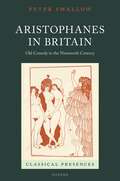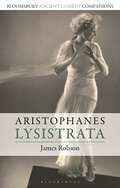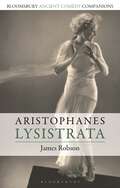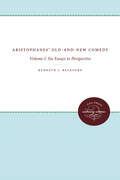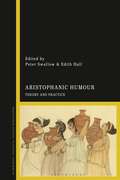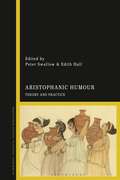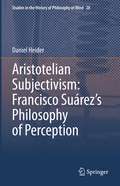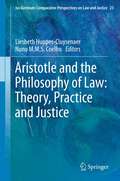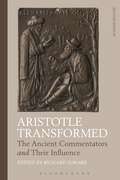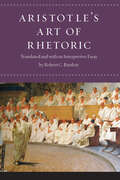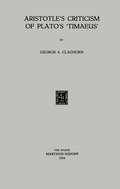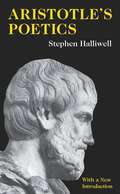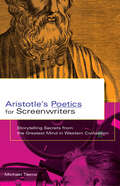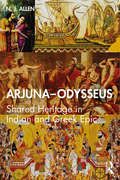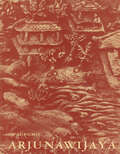- Table View
- List View
Aristophanes in Britain: Old Comedy in the Nineteenth Century (Classical Presences)
by Peter SwallowIn this lively and wide-ranging study, Peter Swallow explores the reception of Aristophanes in Britain throughout the long-nineteenth century, setting it in the broader context of Victorian Classicism and, more specifically, the period's reception of Greek tragedy. Swallow shows the surprising extent to which Aristophanes was repurposed across an array of mediums in Victorian Britain, and demonstrates that Aristophanic reception in the period was always a process of speaking to contemporary issues—making Old Comedy new. The book examines two strands of Aristophanic reception: the political and the aesthetic. From the start of the long-nineteenth century, the British reception of Aristophanes tied into contemporary political debate, as historians, translators and commentators, and even the burlesque writer J.R. Planché activated Aristophanes in support of their own political positions. But each writer's conceptualisation of Aristophanes was as different as their political outlooks. While many writers who appropriated Aristophanes for their cause were Tories, a notable outlier is Percy Shelley, whose Aristophanic drama Swellfoot the Tyrant activated Old Comedy to argue for democratic republicanism—what we would now call a left-wing political revolution. The second strand of Aristophanic reception, which developed from around the middle of the nineteenth century, actively depoliticised Old Comedy and instead received it through an aesthetic lens. The aesthetics of Aristophanes—with an emphasis on the beautiful and the archaeological—also lay behind school and university productions of Old Comedy during this period. These strands of nineteenth-century Aristophanic reception find synthesis towards the book's conclusion. Edwardian women's receptions of Aristophanes show how activists used his plays to argue for equal educational opportunities and the right to vote. In the final chapter, Gilbert Murray and George Bernard Shaw's receptions reveal both the political and artistic potential of Aristophanes.
Aristophanes in Britain: Old Comedy in the Nineteenth Century (Classical Presences)
by Peter SwallowIn this lively and wide-ranging study, Peter Swallow explores the reception of Aristophanes in Britain throughout the long-nineteenth century, setting it in the broader context of Victorian Classicism and, more specifically, the period's reception of Greek tragedy. Swallow shows the surprising extent to which Aristophanes was repurposed across an array of mediums in Victorian Britain, and demonstrates that Aristophanic reception in the period was always a process of speaking to contemporary issues—making Old Comedy new. The book examines two strands of Aristophanic reception: the political and the aesthetic. From the start of the long-nineteenth century, the British reception of Aristophanes tied into contemporary political debate, as historians, translators and commentators, and even the burlesque writer J.R. Planché activated Aristophanes in support of their own political positions. But each writer's conceptualisation of Aristophanes was as different as their political outlooks. While many writers who appropriated Aristophanes for their cause were Tories, a notable outlier is Percy Shelley, whose Aristophanic drama Swellfoot the Tyrant activated Old Comedy to argue for democratic republicanism—what we would now call a left-wing political revolution. The second strand of Aristophanic reception, which developed from around the middle of the nineteenth century, actively depoliticised Old Comedy and instead received it through an aesthetic lens. The aesthetics of Aristophanes—with an emphasis on the beautiful and the archaeological—also lay behind school and university productions of Old Comedy during this period. These strands of nineteenth-century Aristophanic reception find synthesis towards the book's conclusion. Edwardian women's receptions of Aristophanes show how activists used his plays to argue for equal educational opportunities and the right to vote. In the final chapter, Gilbert Murray and George Bernard Shaw's receptions reveal both the political and artistic potential of Aristophanes.
Aristophanes: Lysistrata (Bloomsbury Ancient Comedy Companions)
by James RobsonLysistrata is the most notorious of Aristophanes' comedies. First staged in 411 BCE, its action famously revolves around a sex strike launched by the women of Greece in an attempt to force their husbands to end the war. With its risqué humour, vibrant battle of the sexes, and themes of war and peace, Lysistrata remains as daring and thought-provoking today as it would have been for its original audience in Classical Athens. Aristophanes: Lysistrata is a lively and engaging introduction to this play aimed at students and scholars of classical drama alike. It sets Lysistrata in its social and historical context, looking at key themes such as politics, religion and its provocative portrayal of women, as well as the play's language, humour and personalities, including the formidable and trailblazing Lysistrata herself. Lysistrata has often been translated, adapted and performed in the modern era and this book also traces the ways in which it has been re-imagined and re-presented to new audiences. As this reception history reveals, Lysistrata's appeal in the modern world lies not only in its racy subject matter, but also in its potential to be recast as a feminist, pacifist or otherwise subversive play that openly challenges the political and social status quo.
Aristophanes: Lysistrata (Bloomsbury Ancient Comedy Companions)
by James RobsonLysistrata is the most notorious of Aristophanes' comedies. First staged in 411 BCE, its action famously revolves around a sex strike launched by the women of Greece in an attempt to force their husbands to end the war. With its risqué humour, vibrant battle of the sexes, and themes of war and peace, Lysistrata remains as daring and thought-provoking today as it would have been for its original audience in Classical Athens. Aristophanes: Lysistrata is a lively and engaging introduction to this play aimed at students and scholars of classical drama alike. It sets Lysistrata in its social and historical context, looking at key themes such as politics, religion and its provocative portrayal of women, as well as the play's language, humour and personalities, including the formidable and trailblazing Lysistrata herself. Lysistrata has often been translated, adapted and performed in the modern era and this book also traces the ways in which it has been re-imagined and re-presented to new audiences. As this reception history reveals, Lysistrata's appeal in the modern world lies not only in its racy subject matter, but also in its potential to be recast as a feminist, pacifist or otherwise subversive play that openly challenges the political and social status quo.
Aristophanes' Old-and-New Comedy: Volume I: Six Essays in Perspective
by Kenneth J. ReckfordThis startling and original study emerged from Kenneth Rockford's wish to vindicate Aristophanes' Clouds against detractors. As a result of years of rereading and teaching Aristophanes, he realized that the Clouds could not be defended in an analysis of that play in isolation. A better approach, he decided, would be to define a comic perspective within which Aristophanes' comedies in general as well as the Clouds in particular could be appreciated.This first volume of Reckford's defense examines the comedies as a whole in a series of defining essays, each with its own dominant concern and method of approach. The author begins by exploring not the usual questions of Aristophanes' political attitudes and his place in the development of comedy, but rather the festive, celebratory, and Dionysian nature of Old Comedy. Here and throughout the book Reckford illustrates Aristophanes' form of comedy with analogies to Rabelais, Shakespeare, Charlie Chaplin, Alice in Wonderland, and The Wonderful Wizard of Oz.In the remaining essays Reckford goes beyond the usual Freudian approaches, reinterpreting the comic catharsis as a clarification of wishing and hoping. He also explores the growth of plays from comic idea to comic performance, in ways reflected in Tom Stoppard's plays today. Only then are Aristophanes' basic political loyalties described, as well as the place of his old- and-new comedy within the history of the genre.In a book that is as much about comedy generally as it is about Aristophanes specifically, some plays are treated more fully than others. Reckford discusses the Wasps at length, comparing the symbolic transformations and comic recognitions in the play with dream experience and dream interpretation. He also analyzes the Peace, the Acharians, the Birds, and the Frogs. Reckford's vindication of the Clouds will appear in the second volume of his defense, Clouds of Glory.Reckford's playful translations preserve the puns and anachronisms of Aristophanes, maintaining the playwright's comic feeling and tone. Combining traditional classical scholarship with a variety of literary, psychological, and anthropological approaches, he has written a study that will appeal to both the academic audience and the general reader who cares about comedy.Originally published in 1987.A UNC Press Enduring Edition -- UNC Press Enduring Editions use the latest in digital technology to make available again books from our distinguished backlist that were previously out of print. These editions are published unaltered from the original, and are presented in affordable paperback formats, bringing readers both historical and cultural value.
Aristophanic Humour: Theory and Practice
by Edited by Peter Swallow Edith HallThis volume sets out to discuss a crucial question for ancient comedy – what makes Aristophanes funny? Too often Aristophanes' humour is taken for granted as merely a tool for the delivery of political and social commentary. But Greek Old Comedy was above all else designed to amuse people, to win the dramatic competition by making the audience laugh the hardest. Any discussion of Aristophanes therefore needs to take into account the ways in which his humour actually works.This question is addressed in two ways. The first half of the volume offers an in-depth discussion of humour theory – a field heretofore largely overlooked by classicists and Aristophanists – examining various theoretical models within the specific context of Aristophanes' eleven extant plays. In the second half, contributors explore Aristophanic humour more practically, examining how specific linguistic techniques and performative choices affect the reception of humour, and exploring the range of subjects Aristophanes tackles as vectors for his comedy. A focus on performance shapes the narrative, since humour lives or dies on the stage – it is never wholly comprehensible on the page alone.
Aristophanic Humour: Theory and Practice
This volume sets out to discuss a crucial question for ancient comedy – what makes Aristophanes funny? Too often Aristophanes' humour is taken for granted as merely a tool for the delivery of political and social commentary. But Greek Old Comedy was above all else designed to amuse people, to win the dramatic competition by making the audience laugh the hardest. Any discussion of Aristophanes therefore needs to take into account the ways in which his humour actually works.This question is addressed in two ways. The first half of the volume offers an in-depth discussion of humour theory – a field heretofore largely overlooked by classicists and Aristophanists – examining various theoretical models within the specific context of Aristophanes' eleven extant plays. In the second half, contributors explore Aristophanic humour more practically, examining how specific linguistic techniques and performative choices affect the reception of humour, and exploring the range of subjects Aristophanes tackles as vectors for his comedy. A focus on performance shapes the narrative, since humour lives or dies on the stage – it is never wholly comprehensible on the page alone.
The Aristotelian Mechanics: Text and Diagrams (Boston Studies in the Philosophy and History of Science #316)
by Joyce van LeeuwenThis book examines the transmission processes of the Aristotelian Mechanics. It does so to enable readers to appreciate the value of the treatise based on solid knowledge of the principles of the text. In addition, the book’s critical examination helps clear up many of the current misunderstandings about the transmission of the text and the diagrams. The first part of the book sets out the Greek manuscript tradition of the Mechanics, resulting in a newly established stemma codicum that illustrates the affiliations of the manuscripts. This research has led to new insights into the transmission of the treatise, most importantly, it also demonstrates an urgent need for a new text. A first critical edition of the diagrams contained in the Greek manuscripts of the treatise is also presented. These diagrams are not only significant for a reconstruction of the text but can also be considered as a commentary on the text. Diagrams are thus revealed to be a powerful tool in studying processes of the transfer and transformation of knowledge. This becomes especially relevant when the manuscript diagrams are compared with those in the printed editions and in commentaries from the early modern period. The final part of the book shows that these early modern diagrams and images reflect the altered scope of the mechanical discipline in the sixteenth century.
Aristotelian Subjectivism: Francisco Suárez’s Philosophy of Perception (Studies in the History of Philosophy of Mind #28)
by Daniel HeiderThis monograph presents new material on Francisco Suárez’s comprehensive theory of sense perception. The core theme is perceptual intentionality in Suárez’s theory of the senses, external and internal, as presented in his Commentaria una cum quaestionibus in libros Aristotelis De anima published in 1621. The author targets the question of the multistage genesis of perceptual acts by considering the ontological “items” involved in the procession of sensory information. However, the structural issue is not left aside, and the nature of the relationship due to which our perceptions are mental representations of this or that object is also considered. The heuristic historiographical background includes not only the theories of classical authors, such as Aristotle and Aquinas, but also those of late medieval authors of the fourteenth century. These are headed by John Duns Scotus, John of Jandun, Peter Auriol and Peter John Olivi. Readers will discover the differences between Suárez’s and Aquinas’s views, as well as other sources that may have served as positive inspiration for the Jesuit’s theory. By considering the late medieval philosophy of the fourteenth century, this book helps, to a certain extent, to fill a gap in the historiography of philosophy regarding the link between late medieval and early modern scholasticism. In the first part of the book, the metaphysics of the soul and powers is considered. Chapters on the external senses follow, covering topics such as the sensible species, the causes of sensation, self-awareness, and the ordering of the external senses. A further chapter is devoted to the internal senses and the author argues that by reducing the number and functional scope of the interior senses Suárez deepens the gap between the external senses and the intellect, but he reduces it through emphasizing the unifying efficacy of the soul.This book brings a synthetic and unifying perspective to contemporary research and will particularly appeal to graduate students and researchers in theology and philosophy, especially philosophy of mind.
Aristotle and The Philosophy of Law: Theory, Practice and Justice (Ius Gentium: Comparative Perspectives on Law and Justice)
by Liesbeth Huppes-Cluysenaer and Nuno M.M.S. CoelhoThe book presents a new focus on the legal philosophical texts of Aristotle, which offers a much richer frame for the understanding of practical thought, legal reasoning and political experience. It allows understanding how human beings interact in a complex world, and how extensive the complexity is which results from humans’ own power of self-construction and autonomy. The Aristotelian approach recognizes the limits of rationality and the inevitable and constitutive contingency in Law. All this offers a helpful instrument to understand the changes globalisation imposes to legal experience today.The contributions in this collection do not merely pay attention to private virtues, but focus primarily on public virtues. They deal with the fact that law is dependent on political power and that a person can never be sure about the facts of a case or about the right way to act. They explore the assumption that a detailed knowledge of Aristotle's epistemology is necessary, because of the direct connection between Enlightened reasoning and legal positivism. They pay attention to the concept of proportionality, which can be seen as a precondition to discuss liberalism.
Aristotle Transformed: The Ancient Commentators and Their Influence
by Richard SorabjiThis book brings together twenty articles giving a comprehensive view of the work of the Aristotelian commentators. First published in 1990, the collection is now brought up to date with a new introduction by Richard Sorabji. New generations of scholars will benefit from this reissuing of classic essays, including seminal works by major scholars, and the volume gives a comprehensive background to the work of the project on the Ancient Commentators on Aristotle, which has published over 100 volumes of translations since 1987 and has disseminated these crucial texts to scholars worldwide.The importance of the commentators is partly that they represent the thought and classroom teaching of the Aristotelian and Neoplatonist schools and partly that they provide a panorama of a thousand years of ancient Greek philosophy, revealing many original quotations from lost works. Even more significant is the profound influence – uncovered in some of the chapters of this book – that they exert on later philosophy, Islamic and Western. Not only did they preserve anti-Aristotelian material which helped inspire Medieval and Renaissance science, but they present Aristotle in a form that made him acceptable to the Christian church. It is not Aristotle, but Aristotle transformed and embedded in the philosophy of the commentators that so often lies behind the views of later thinkers.
Aristotle Transformed: The Ancient Commentators and Their Influence
by Richard SorabjiThis book brings together twenty articles giving a comprehensive view of the work of the Aristotelian commentators. First published in 1990, the collection is now brought up to date with a new introduction by Richard Sorabji. New generations of scholars will benefit from this reissuing of classic essays, including seminal works by major scholars, and the volume gives a comprehensive background to the work of the project on the Ancient Commentators on Aristotle, which has published over 100 volumes of translations since 1987 and has disseminated these crucial texts to scholars worldwide.The importance of the commentators is partly that they represent the thought and classroom teaching of the Aristotelian and Neoplatonist schools and partly that they provide a panorama of a thousand years of ancient Greek philosophy, revealing many original quotations from lost works. Even more significant is the profound influence – uncovered in some of the chapters of this book – that they exert on later philosophy, Islamic and Western. Not only did they preserve anti-Aristotelian material which helped inspire Medieval and Renaissance science, but they present Aristotle in a form that made him acceptable to the Christian church. It is not Aristotle, but Aristotle transformed and embedded in the philosophy of the commentators that so often lies behind the views of later thinkers.
Aristotle's "Art of Rhetoric"
by AristotleFor more than two thousand years. Aristotle’s “Art of Rhetoric” has shaped thought on the theory and practice of rhetoric, the art of persuasive speech. In three sections, Aristotle discusses what rhetoric is, as well as the three kinds of rhetoric (deliberative, judicial, and epideictic), the three rhetorical modes of persuasion, and the diction, style, and necessary parts of a successful speech. Throughout, Aristotle defends rhetoric as an art and a crucial tool for deliberative politics while also recognizing its capacity to be misused by unscrupulous politicians to mislead or illegitimately persuade others. Here Robert C. Bartlett offers a literal, yet easily readable, new translation of Aristotle’s “Art of Rhetoric,” one that takes into account important alternatives in the manuscript and is fully annotated to explain historical, literary, and other allusions. Bartlett’s translation is also accompanied by an outline of the argument of each book; copious indexes, including subjects, proper names, and literary citations; a glossary of key terms; and a substantial interpretive essay.
Aristotle's "Art of Rhetoric"
by AristotleFor more than two thousand years. Aristotle’s “Art of Rhetoric” has shaped thought on the theory and practice of rhetoric, the art of persuasive speech. In three sections, Aristotle discusses what rhetoric is, as well as the three kinds of rhetoric (deliberative, judicial, and epideictic), the three rhetorical modes of persuasion, and the diction, style, and necessary parts of a successful speech. Throughout, Aristotle defends rhetoric as an art and a crucial tool for deliberative politics while also recognizing its capacity to be misused by unscrupulous politicians to mislead or illegitimately persuade others. Here Robert C. Bartlett offers a literal, yet easily readable, new translation of Aristotle’s “Art of Rhetoric,” one that takes into account important alternatives in the manuscript and is fully annotated to explain historical, literary, and other allusions. Bartlett’s translation is also accompanied by an outline of the argument of each book; copious indexes, including subjects, proper names, and literary citations; a glossary of key terms; and a substantial interpretive essay.
Aristotle's "Art of Rhetoric"
by AristotleFor more than two thousand years. Aristotle’s “Art of Rhetoric” has shaped thought on the theory and practice of rhetoric, the art of persuasive speech. In three sections, Aristotle discusses what rhetoric is, as well as the three kinds of rhetoric (deliberative, judicial, and epideictic), the three rhetorical modes of persuasion, and the diction, style, and necessary parts of a successful speech. Throughout, Aristotle defends rhetoric as an art and a crucial tool for deliberative politics while also recognizing its capacity to be misused by unscrupulous politicians to mislead or illegitimately persuade others. Here Robert C. Bartlett offers a literal, yet easily readable, new translation of Aristotle’s “Art of Rhetoric,” one that takes into account important alternatives in the manuscript and is fully annotated to explain historical, literary, and other allusions. Bartlett’s translation is also accompanied by an outline of the argument of each book; copious indexes, including subjects, proper names, and literary citations; a glossary of key terms; and a substantial interpretive essay.
Aristotle's "Art of Rhetoric"
by AristotleFor more than two thousand years. Aristotle’s “Art of Rhetoric” has shaped thought on the theory and practice of rhetoric, the art of persuasive speech. In three sections, Aristotle discusses what rhetoric is, as well as the three kinds of rhetoric (deliberative, judicial, and epideictic), the three rhetorical modes of persuasion, and the diction, style, and necessary parts of a successful speech. Throughout, Aristotle defends rhetoric as an art and a crucial tool for deliberative politics while also recognizing its capacity to be misused by unscrupulous politicians to mislead or illegitimately persuade others. Here Robert C. Bartlett offers a literal, yet easily readable, new translation of Aristotle’s “Art of Rhetoric,” one that takes into account important alternatives in the manuscript and is fully annotated to explain historical, literary, and other allusions. Bartlett’s translation is also accompanied by an outline of the argument of each book; copious indexes, including subjects, proper names, and literary citations; a glossary of key terms; and a substantial interpretive essay.
Aristotle's "Art of Rhetoric"
by AristotleFor more than two thousand years. Aristotle’s “Art of Rhetoric” has shaped thought on the theory and practice of rhetoric, the art of persuasive speech. In three sections, Aristotle discusses what rhetoric is, as well as the three kinds of rhetoric (deliberative, judicial, and epideictic), the three rhetorical modes of persuasion, and the diction, style, and necessary parts of a successful speech. Throughout, Aristotle defends rhetoric as an art and a crucial tool for deliberative politics while also recognizing its capacity to be misused by unscrupulous politicians to mislead or illegitimately persuade others. Here Robert C. Bartlett offers a literal, yet easily readable, new translation of Aristotle’s “Art of Rhetoric,” one that takes into account important alternatives in the manuscript and is fully annotated to explain historical, literary, and other allusions. Bartlett’s translation is also accompanied by an outline of the argument of each book; copious indexes, including subjects, proper names, and literary citations; a glossary of key terms; and a substantial interpretive essay.
Aristotle's "Art of Rhetoric"
by AristotleFor more than two thousand years. Aristotle’s “Art of Rhetoric” has shaped thought on the theory and practice of rhetoric, the art of persuasive speech. In three sections, Aristotle discusses what rhetoric is, as well as the three kinds of rhetoric (deliberative, judicial, and epideictic), the three rhetorical modes of persuasion, and the diction, style, and necessary parts of a successful speech. Throughout, Aristotle defends rhetoric as an art and a crucial tool for deliberative politics while also recognizing its capacity to be misused by unscrupulous politicians to mislead or illegitimately persuade others. Here Robert C. Bartlett offers a literal, yet easily readable, new translation of Aristotle’s “Art of Rhetoric,” one that takes into account important alternatives in the manuscript and is fully annotated to explain historical, literary, and other allusions. Bartlett’s translation is also accompanied by an outline of the argument of each book; copious indexes, including subjects, proper names, and literary citations; a glossary of key terms; and a substantial interpretive essay.
Aristotle's "Art of Rhetoric"
by AristotleFor more than two thousand years. Aristotle’s “Art of Rhetoric” has shaped thought on the theory and practice of rhetoric, the art of persuasive speech. In three sections, Aristotle discusses what rhetoric is, as well as the three kinds of rhetoric (deliberative, judicial, and epideictic), the three rhetorical modes of persuasion, and the diction, style, and necessary parts of a successful speech. Throughout, Aristotle defends rhetoric as an art and a crucial tool for deliberative politics while also recognizing its capacity to be misused by unscrupulous politicians to mislead or illegitimately persuade others. Here Robert C. Bartlett offers a literal, yet easily readable, new translation of Aristotle’s “Art of Rhetoric,” one that takes into account important alternatives in the manuscript and is fully annotated to explain historical, literary, and other allusions. Bartlett’s translation is also accompanied by an outline of the argument of each book; copious indexes, including subjects, proper names, and literary citations; a glossary of key terms; and a substantial interpretive essay.
Aristotle’s Criticism of Plato’s ‘Timaeus’
by George S. ClaghornThe purpose of this study is to determine Aristotle's attitude toward the content and method of Plato's natural science. Plato and Aristotle have often been regarded as on opposite sides of a philosophic 'Great Divide'. On the other hand, those who have found that the two men were in agreement have sometimes mentioned only scattered instances of that agreement. There is need for a new comparison of the two philosopher- one which is limited in scope, based on the primary texts, and which is systematic and thorough in method. If successful, such a comparison would bring into sharp focus one phase of Aristotle's comments on Plato. Our attempt to meet this need is Aristotle's Criticism of Plato's TIMAEUS. In pursuing this study, it has been necessary to reject a number of uncritically-accepted interpre tations of the Timaeus. Contrary to the view of many, we have concluded that Aristotle largely agreed with Plato, both in the principles and presuppositions of his natural science. A number of implications stem from this study. There is, for example, the oft-questioned manner in which Aristotle treated Plato's philosophy. In the great majority of instances, Aristotle stands forth as a reliable reporter and a skilled critic. Moreover, the study sheds light on that ancient riddle: whether Plato and Aristotle are basically akin or at odds in their general philosophies.
Aristotle's Poetics: Literally Translated, With Explanatory Notes, And An Analysis (classic Reprint)
by Stephen HalliwellIn this, the fullest, sustained interpretation of Aristotle's Poetics available in English, Stephen Halliwell demonstrates that the Poetics, despite its laconic brevity, is a coherent statement of a challenging theory of poetic art, and it hints towards a theory of mimetic art in general. Assessing this theory against the background of earlier Greek views on poetry and art, particularly Plato's, Halliwell goes further than any previous author in setting Aristotle's ideas in the wider context of his philosophical system. The core of the book is a fresh appraisal of Aristotle's view of tragic drama, in which Halliwell contends that at the heart of the Poetics lies a philosophical urge to instill a secularized understanding of Greek tragedy. "Essential reading not only for all serious students of the Poetics . . . but also for those—the great majority—who have prudently fought shy of it altogether."—B. R. Rees, Classical Review "A splendid work of scholarship and analysis . . . a brilliant interpretation."—Alexander Nehamas, Times Literary Supplement
Aristotle's Poetics for Screenwriters: Storytelling Secrets from the Greatest Mind in Western Civilization
by Michael TiernoAn insightful how-to guide for writing screenplays that uses Aristotle's great work as a guide. Long considered the bible for storytellers, Aristotle's Poetics is a fixture of college courses on everything from fiction writing to dramatic theory. Now Michael Tierno shows how this great work can be an invaluable resource to screenwriters or anyone interested in studying plot structure. In carefully organized chapters, Tierno breaks down the fundamentals of screenwriting, highlighting particular aspects of Aristotle's work. Then, using examples from some of the best movies ever made, he demonstrates how to apply these ancient insights to modern-day screenwriting. This user-friendly guide covers a multitude of topics, from plotting and subplotting to dialogue and dramatic unity. Writing in a highly readable, informal tone, Tierno makes Aristotle's monumental work accessible to beginners and pros alike in areas such as screenwriting, film theory, fiction, and playwriting.
Arjuna–Odysseus: Shared Heritage in Indian and Greek Epic
by N. J. AllenBringing together the study of the Greek classics and Indology, Arjuna–Odysseus provides a comparative analysis of the shared heritage of the Mahābhārata and early Greek traditions presented in the texts of Homer and Hesiod. Building on the ethnographic theories of Durkheim, Mauss, and Dumont, the volume explores the convergences and rapprochements between the Mahābhārata and the Greek texts. In exploring the networks of similarities between the two epic traditions, it also reformulates the theory of Georges Dumézil regarding Indo-European cultural comparativism. It includes a detailed comparison between journeys undertaken by the two epic heroes – Odysseus and Arjuna – and more generally, it ranges across the philosophical ideas of these cultures, and the epic traditions, metaphors, and archetypes that define the cultural ideology of ancient Greece and India. This book will be useful to scholars and researchers of Indo-European comparativism, social and cultural anthropology, classical literature, Indology, cultural and post-colonial studies, philosophy and religion, as well as to those who love the Indian and Greek epics.
Arjuna–Odysseus: Shared Heritage in Indian and Greek Epic
by N. J. AllenBringing together the study of the Greek classics and Indology, Arjuna–Odysseus provides a comparative analysis of the shared heritage of the Mahābhārata and early Greek traditions presented in the texts of Homer and Hesiod. Building on the ethnographic theories of Durkheim, Mauss, and Dumont, the volume explores the convergences and rapprochements between the Mahābhārata and the Greek texts. In exploring the networks of similarities between the two epic traditions, it also reformulates the theory of Georges Dumézil regarding Indo-European cultural comparativism. It includes a detailed comparison between journeys undertaken by the two epic heroes – Odysseus and Arjuna – and more generally, it ranges across the philosophical ideas of these cultures, and the epic traditions, metaphors, and archetypes that define the cultural ideology of ancient Greece and India. This book will be useful to scholars and researchers of Indo-European comparativism, social and cultural anthropology, classical literature, Indology, cultural and post-colonial studies, philosophy and religion, as well as to those who love the Indian and Greek epics.
